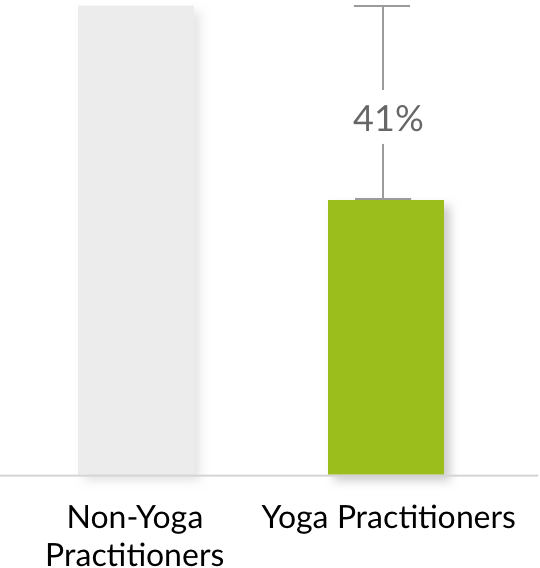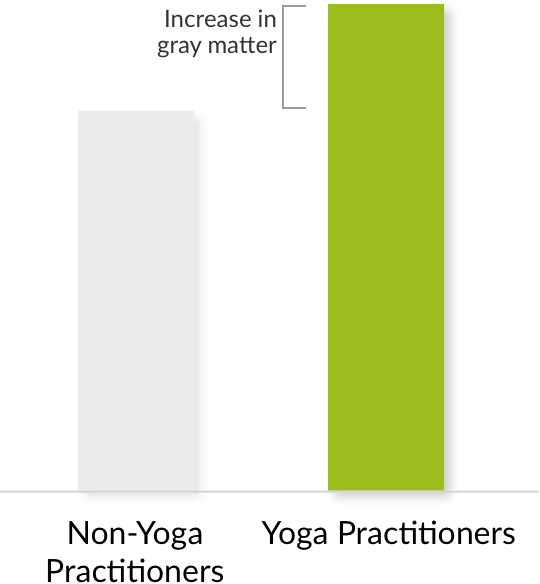
 Yoga & Blood Pressure
Yoga & Blood Pressure
According to as 2016 study in the Journal of Clinical Hypertension, practicing yoga 2-3 times per week for 3 months resulted in a mean 3 mm HG drop in systolic blood pressure. A systolic blood pressure reading (the 'top' number) dropping by 2 mm Hg cuts the risk of dying from heart disease by 7% and the risk of stroke death by 10%.
After a 12 week pilot, the researchers did a randomized, non-blinded, prospective, controlled trial over 24 weeks in adults with prehypertension and stage 1 hypertension comparing yoga and blood pressure education as interventions. As an intervention, the difference in improvements by yoga were significant at 12 weeks, but not at 24. Although the improvements in blood pressure were small, the authors believe they could be important as even a small reduction in blood pressure has health benefits. Research shows that even a systolic blood pressure reading (the 'top' number) dropping by 2 mm Hg cuts the risk of dying from heart disease by 7 percent and the risk of stroke death by 10 percent.
Cohen et al. J Clin Hypertension (2016)

Yoga & Blood Pressure
According to as 2016 study in the Journal of Clinical Hypertension, practicing yoga 2-3 times per week for 3 months resulted in a mean 3 mm HG drop in systolic blood pressure. A systolic blood pressure reading (the 'top' number) dropping by 2 mm Hg cuts the risk of dying from heart disease by 7% and the risk of stroke death by 10%.
After a 12 week pilot, the researchers did a randomized, non-blinded, prospective, controlled trial over 24 weeks in adults with prehypertension and stage 1 hypertension comparing yoga and blood pressure education as interventions. As an intervention, the difference in improvements by yoga were significant at 12 weeks, but not at 24. Although the improvements in blood pressure were small, the authors believe they could be important as even a small reduction in blood pressure has health benefits. Research shows that even a systolic blood pressure reading (the 'top' number) dropping by 2 mm Hg cuts the risk of dying from heart disease by 7 percent and the risk of stroke death by 10 percent.
Cohen et al. J Clin Hypertension (2016)
 Yoga & Inflammation
Yoga & Inflammation
According to research done at Ohio State University, women who practice yoga regularly for at least two years have 41% less serum IL-6 levels, a marker of inflammation in their bodies, than women who only recently have taken up the activity.
Chronically high levels of inflammation are known to play a role in certain conditions, including asthma, cardiovascular disease and depression. Participants completed three stressful tasks in succession, but when yoga experts were exposed to stress, they experienced 41% less inflammation than yoga novices did. Subjects had catheters placed in their arms to collect blood samples periodically for key markers of inflammation, one of which is a protein called IL-6. Across all the tasks and other experimental scenarios, the seasoned yogis' IL-6 levels were 41% lower than the novices'. Yoga focuses on deep breathing and controlling breathing, which may slow down the body's "fight or flight" response. Yoga also involves meditation, which helps people learn to pay attention to how they are feeling. So yoga experts may be more aware of their stress and better able to control their response to it. Finally, yoga is a form of exercise, which is known to decrease inflammation.
Kiecolt-Glaser et al., Psychosom Med. (2010)

Yoga & Inflammation
 Yoga & Body Composition
Yoga & Body Composition
A 2014 meta-analysis review of asana-based yoga interventions in adults found that yoga showed significant improvement for body mass index (−0.77 kg/m2) and significant changes in body weight (−2.32 kg).
The authors conducted a systematic review and random-effects meta-analysis of randomized controlled trials (RCTs), and included studies if in English, peer-reviewed, focused on asana-based yoga in adults, and reported relevant outcomes. Two reviewers independently selected articles and assessed quality using Cochrane’s Risk of Bias tool. Out of 1404 records, 37 RCTs were included in the systematic review and 32 in the meta-analysis. Compared to non-exercise controls, yoga showed significant improvement for body mass index (−0.77 kg/m2 (95% confidence interval −1.09 to −0.44)), systolic blood pressure (−5.21 mmHg (−8.01 to −2.42)), low-density lipoprotein cholesterol (−12.14 mg/dl (−21.80 to −2.48)), and high-density lipoprotein cholesterol (3.20 mg/dl (1.86 to 4.54)). Significant changes were seen in body weight (−2.32 kg (−4.33 to −0.37)), diastolic blood pressure (−4.98 mmHg (−7.17 to −2.80)), total cholesterol (−18.48 mg/dl (−29.16 to −7.80)), triglycerides (−25.89 mg/dl (−36.19 to −15.60), and heart rate (−5.27 beats/min (−9.55 to −1.00)), but not fasting blood glucose (−5.91 mg/dl (−16.32 to 4.50)) nor glycosylated hemoglobin (−0.06% Hb (−0.24 to 0.11)). The researchers recognized that findings are limited by small trial sample sizes, heterogeneity, and moderate quality of RCT but conclude there is promising evidence of yoga on improving cardio-metabolic health.
Chu et al. Eur J Prev Card (2014)

Yoga & Body Composition
A 2014 meta-analysis review of asana-based yoga interventions in adults found that yoga showed significant improvement for body mass index (−0.77 kg/m2) and significant changes in body weight (−2.32 kg).
The authors conducted a systematic review and random-effects meta-analysis of randomized controlled trials (RCTs), and included studies if in English, peer-reviewed, focused on asana-based yoga in adults, and reported relevant outcomes. Two reviewers independently selected articles and assessed quality using Cochrane’s Risk of Bias tool. Out of 1404 records, 37 RCTs were included in the systematic review and 32 in the meta-analysis. Compared to non-exercise controls, yoga showed significant improvement for body mass index (−0.77 kg/m2 (95% confidence interval −1.09 to −0.44)), systolic blood pressure (−5.21 mmHg (−8.01 to −2.42)), low-density lipoprotein cholesterol (−12.14 mg/dl (−21.80 to −2.48)), and high-density lipoprotein cholesterol (3.20 mg/dl (1.86 to 4.54)). Significant changes were seen in body weight (−2.32 kg (−4.33 to −0.37)), diastolic blood pressure (−4.98 mmHg (−7.17 to −2.80)), total cholesterol (−18.48 mg/dl (−29.16 to −7.80)), triglycerides (−25.89 mg/dl (−36.19 to −15.60), and heart rate (−5.27 beats/min (−9.55 to −1.00)), but not fasting blood glucose (−5.91 mg/dl (−16.32 to 4.50)) nor glycosylated hemoglobin (−0.06% Hb (−0.24 to 0.11)). The researchers recognized that findings are limited by small trial sample sizes, heterogeneity, and moderate quality of RCT but conclude there is promising evidence of yoga on improving cardio-metabolic health.
Chu et al. Eur J Prev Card (2014)
 Yoga & Brain Health
Yoga & Brain Health
According to a 2015 article in Frontiers in Human Neuroscience, practicing yoga regularly leads to more gray matter — brain cells — in certain brain areas and that regular practice of yoga may have neuroprotective effects against whole brain age-related GM decline.
In this study, the yogis dedicated on average about 70 percent of their practice to physical postures, about 20 percent to meditation and 10 percent to breath work, typical of most Western yoga routines. They also found that the more hours of practice per week, the bigger the increase in brain cells.
Villemure et al. Front Hum Neurosci (2015)

Yoga & Brain Health


We are a licensed life insurance agent* in all 50 states.
View our licenses
We negotiated lower rates on life insurance using science and data.
View our research
By yogis for yogis. Our team is comprised of health conscious people who overcame their own health challenges with healthy habits, exercise, and nutrition.
Meet our team














